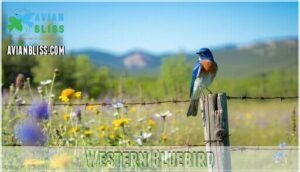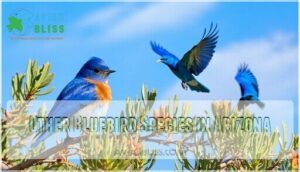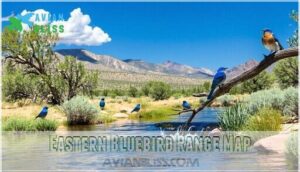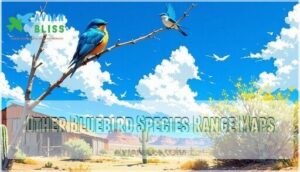This site is supported by our readers. We may earn a commission, at no cost to you, if you purchase through links.

The state hosts three true bluebird species—Eastern, Western, and Mountain—plus ten other azure beauties like Steller’s Jays, Lazuli Buntings, and Purple Martins.
These birds thrive in Arizona’s diverse habitats year-round, from desert lowlands to mountain peaks.
Each species has unique behaviors and preferred environments that make identification easier once you know what to look for, and the secret lies in understanding their specific calls, flight patterns, and favorite hangout spots.
Table Of Contents
Key Takeaways
- You’ll find 13 blue bird species in Arizona, including three true bluebirds (Eastern, Western, and Mountain) plus ten other blue-colored birds like Steller’s Jays and Blue Grosbeaks that thrive in the state’s diverse habitats year-round.
- You can attract bluebirds to your yard by offering live mealworms in specialized feeders, planting native berry bushes, providing nest boxes with proper placement, and maintaining clean water sources away from busy feeding areas.
- You’ll identify different species by learning their unique calls, flight patterns, and habitat preferences—Mountain Bluebirds prefer high elevations, Western Bluebirds stick to oak woodlands, and Eastern Bluebirds favor open grasslands during winter months.
- You’ll support bluebird conservation by installing predator-proof nest boxes, monitoring breeding success weekly, preserving open woodlands and grasslands, and participating in citizen science projects that track migration patterns.
Eastern Bluebird
You’ll often spot Eastern Bluebirds perched on fence posts and power lines across Arizona’s open grasslands and agricultural areas, especially during winter months when northern populations migrate south.
These robin-sized songbirds display striking royal blue upperparts with rusty orange throats and white bellies, making them one of the most beloved backyard visitors you can attract with proper nest boxes and mealworm feeders.
Based on the content about bluebirds in Arizona, here’s a short, engaging blockquote that captures the same enthusiastic tone:
These brilliant azure jewels turn any backyard into a living postcard with their stunning colors and gentle songs.
Appearance, Habitat, and Diet
When you encounter Eastern Bluebirds in Arizona’s open meadows, you’ll recognize males by their brilliant royal blue backs and warm orange breasts, while females display softer gray-brown plumage with blue wing highlights.
These cavity-nesting songbirds thrive in grasslands with scattered perches, shifting their diet seasonally from protein-rich insects like beetles and caterpillars during breeding season to nutrient-dense berries and fruits throughout winter months.
Identifying Features of Eastern Bluebirds:
- Males – Deep blue upperparts with rusty-orange throat and breast, white belly
- Females – Grayish-brown back with blue wings and tail, pale orange-buff chest
- Size – Approximately 7 inches long with stocky robin-like build
- Habitat – Open fields, meadows, and grasslands with scattered trees or fence posts
- Diet – Insects (spring/summer), berries and small fruits (fall/winter)
Attracting Eastern Bluebirds
Eastern Bluebird’s beauty graces Arizona backyards when you create the right environment.
Install nest boxes with proper placement away from busy feeders, maintaining predator control measures protect families.
Offer mealworms and native plant berries through specialized feeders, maintaining water sources year-round.
You may want to think about buying an appropriate bluebird house.
Winter feeding helps sustain these stunning blue birds Arizona residents cherish, supporting backyard birds Arizona communities while contributing to Eastern Bluebird conservation efforts.
Conservation Efforts
Several conservation strategies help protect Eastern Bluebirds in Arizona:
- Habitat Preservation – Maintain open woodlands and grasslands where blue birds arizona thrive
- Nest Box Monitoring – Install and check boxes weekly during breeding season
- Native Vegetation – Plant berry-producing shrubs for natural food sources
- Feeder Placement – Position feeders away from nest boxes
- Competition Prevention – Control invasive species competing for nesting sites
These arizona bird conservation efforts create sustainable environments supporting bluebird populations statewide.
Expanding protected areas can improve population trends.
Western Bluebird
You’ll spot Western Bluebirds across Arizona’s oak woodlands and pine forests, where males flash deep blue heads and backs with striking reddish-orange chests.
Unlike their Eastern cousins who prefer open meadows, these birds stick to wooded areas and hunt insects by perching on branches before swooping down to catch their prey, utilizing a unique method that involves perching on branches.
Habitat and Behavior
Western Bluebirds thrive in open woodlands and forest edges across arizona wildlife habitats, hunting insects from perches with precise foraging strategies.
These arizona bird species exhibit strong territoriality during breeding season, defending nest sites aggressively.
Their nesting preferences include natural cavities and nest boxes in semi-open areas.
Social interactions increase during winter when flocks form for roosting behavior. You’ll spot these blue colored birds year-round in coniferous forests, switching from insects to berries seasonally while maintaining their blue bird habitat territories.
Key Differences From Eastern Bluebirds
While spotting Western bluebirds in Arizona, you’ll notice striking coloration differences from their Eastern cousins.
Western males show deeper blue throat coloring, while females display distinct orange throat markings versus Eastern females’ white.
These Arizona blue birds prefer prairie-oak habitat preferences over Eastern species’ open meadows.
Diet variations include more specialized woodland foraging behaviors.
Western bluebirds demonstrate stronger nesting habits tied to specific snag features, showing less flexibility than Eastern species in nest site selection across arizona bird species.
Eastern bluebirds, however, often nest in old woodpecker holes.
Nest Box Assistance
If you’re hoping to hear more blue colored birds singing in your yard, nest box assistance is your best bet. Start with Box Placement—set up boxes facing open fields or lawns, steering clear of dense woods.
Use untreated, rough-cut wood for better grip and insulation. Add Predator Guards to keep curious critters away.
Check boxes weekly (Box Monitoring) during nesting season; peeking in won’t bother these arizona birds. Keep records of eggs and fledglings to track success.
Don’t forget Box Maintenance—clean boxes after each season to prevent pests. To further enhance the nest box, consider optimal height and orientation to protect from harsh weather.
For extra appeal, offer soft Nesting Material nearby. These steps help arizona blue birds and other backyard birds feel at home and boost local bird nesting.
- Choose open, sunny locations
- Install Predator Guards
- Clean boxes every season
- Offer safe Nesting Material
- Monitor for Box Maintenance
Mountain Bluebird
You’ll spot the Mountain Bluebird by its sky-blue feathers and pale belly, often perched in open grasslands or high mountain meadows.
If you see a flash of blue that looks like it just escaped a paint set, you’ve probably found one.
Appearance and Habitat
If you’re scanning for blue colored birds in Arizona, the Mountain Bluebird stands out with its vivid sky-blue plumage—think a splash of paint against the landscape.
Look for these Arizona native birds in open meadows and high-elevation slopes with scattered trees. Their identifying features and plumage variations make blue bird identification easy.
Here’s a quick guide:
| Identifying Features | Habitat Preferences |
|---|---|
| Sky-blue feathers | Open meadows |
| Pale belly | Mountain slopes |
| Darker wings | Scattered shrubs |
| Medium size | Parks, grasslands |
Their identifying features and plumage variations are key to recognizing these birds in their natural habitat.
Diet and Hunting Skills
After spotting their bright blue feathers, you’ll notice mountain bluebirds are true pros at catching flying insects.
Their Hunting Techniques include quick swoops and sharp turns, making them expert aerial hunters.
In summer, Insect Consumption dominates their bird diet, but once winter hits, Berry Preference takes over.
These insectivorous birds shift their Foraging Strategies, searching for fruits and berries, showing just how adaptable their bird feeding habits are.
Other Bluebird Species in Arizona
You’ll spot more than just the classic bluebirds in Arizona, since several other blue-hued species share these habitats.
If you’ve ever mistaken a jay or a swallow for a bluebird, you’re not alone—these birds display a surprising range of blue shades and behaviors.
Barn Swallow
Looking at the Barn Swallow among common arizona birds, you’ll spot this blue colored birds species performing aerial acrobatics while hunting.
Their steel-blue backs shimmer as they demonstrate expert skimming behavior across water surfaces.
These masters of mud nesting build homes under eaves in urban habitats.
Their insect diet includes beetles and flies caught mid-flight, showcasing incredible flying skills through precise maneuvers and acrobatic displays.
Cliff Swallow
Cliff swallows create architectural marvels with their distinctive gourd-shaped mud nests clustered under bridges and overhangs.
These blue colored birds aren’t true bluebirds, but their aerial acrobatics make them fascinating to watch.
You’ll often spot hundreds nesting together in massive colonies visible from considerable distances.
- Cliff Swallow ID: Orange-red rump patch, square tail, and creamy forehead distinguish them from barn swallow cousins
- Mud Construction: They gather pellets of wet clay to build enclosed nests with small entrance holes
- Coloniality: Nesting colonies can contain thousands of pairs working together in perfect harmony
- Migration Routes: These long-distance travelers winter in South America, returning each spring to Arizona
- Diet: Expert insect catchers that help control mosquito and fly populations around water sources
Their synchronized colony behavior creates impressive displays when identifying blue birds during Arizona’s breeding season.
Belted Kingfisher
These royal blue-gray birds patrol Arizona streams like feathered fishermen.
The Belted Kingfisher’s massive head and dagger-like bill make perfect fishing tools.
They excavate tunnel nests in riverbanks, diving from perches to snatch fish, frogs, and crayfish.
Their rattling call echoes across waterways where clean habitat supports healthy populations throughout Arizona’s riparian zones.
Purple Martin
Purple martins occasionally grace Arizona during migration, though they don’t breed here.
These largest North American swallows sport deep purple-blue plumage that gleams in sunlight.
You’ll spot them near water bodies where insects are abundant, as they’re aerial hunters specializing in flying prey.
Martin identification features:
- Dark purple-blue males with slightly forked tails
- Brownish females with lighter underparts
- Distinctive swooping flight patterns over water
- Colonial nesting behavior in specialized habitats
Migration brings them through Arizona briefly during spring and fall journeys.
Conservation efforts focus on providing proper nest sites in their breeding ranges.
These blue-colored birds require specific conditions, making Arizona sightings special occasions for dedicated observers during their brief passages through the state.
Tree Swallow
Tree Swallow males showcase stunning metallic plumage in dark blue-green, while females appear brown.
You’ll spot their distinctive notched tail as they perform aerial insectivore feeding near water sources.
These arizona bird species compete with bluebirds for nesting sites.
During swallow migration, they travel to Central America for winter.
Their nesting habits involve cavity selection, making proper bird identification essential for arizona bird watching and supporting arizona bird guide conservation efforts.
Their unique characteristics and behaviors, such as aerial insectivore feeding, are crucial for understanding and appreciating these birds.
Blue Grosbeak
You’ll spot Blue Grosbeaks at eight inches with their brilliant azure plumage and massive silver bills.
These arizona desert birds prefer thick shrubbery near water sources for Grosbeak Nesting.
Grosbeak Diet includes seeds, grains, and insects during breeding season. Males showcase deep blue coloring while females display light cinnamon tones.
Grosbeak Identification becomes easier when you notice their distinctive cone-shaped bills.
Grosbeak Migration brings them north from Mexico each spring. They’ll visit your feeders for birdseed and grain, making them welcome additions to any arizona bird guide for blue colored birds enthusiasts.
Lazuli Bunting
When spring arrives in Arizona desert birds habitats, male Lazuli Bunting flash brilliant blue among sagebrush and chaparral.
These Passerina amoena specimens hunt insects while delivering sweet Bunting Song melodies.
Bunting Identification features include cone-shaped bills and orange-cinnamon chests.
Their Breeding Habits involve low shrub nesting before migrating to Wintering Grounds.
Blue colored birds enthusiasts enjoy birdwatching Arizona locations where the Conservation Status remains stable.
Steller’s Jay
Meet Arizona’s crown jewel of the jay family, the Steller’s Jay, which commands attention with its striking crested appearance and bold personality.
You’ll spot these brilliant blue colored birds in Arizona’s mountain forests, where their harsh vocalizations echo through ponderosa pines and Douglas firs.
The Stellers Jay habitat spans elevations from 3,000 to 10,000 feet across Arizona’s mountainous regions, and their diet includes acorns, pine nuts, insects, and occasionally bird eggs.
Their raucous calls make birdwatching these intelligent bird species unforgettable as they dominate their woodland territories.
Pinyon Jay
You’ll encounter Pinyon Jays gathering in massive flocks throughout Arizona’s pine-juniper woodlands, where these intelligent birds cache thousands of seeds for winter survival.
These social creatures demonstrate remarkable memory skills, remembering countless hiding spots across their territory. Their nomadic lifestyle follows food availability, making them unpredictable yet fascinating subjects for Arizona birdwatching enthusiasts.
- Watch for their brilliant gray-blue plumage gleaming in dappled sunlight
- Listen to their raucous calls echoing through ancient pinyon groves
- Marvel at their incredible teamwork during seed-gathering expeditions
- Feel the excitement when spotting these conservation-dependent treasures
Woodhouse’s Scrub-Jay
Azure-headed birds with striking crests make excellent Arizona residents year-round.
Woodhouse’s Scrub-Jays display azure blue upper head, wings, and tail contrasting with dark gray shoulders and light gray belly.
These intelligent birds demonstrate complex Scrub-Jay Behavior including food caching and vocal mimicry.
Their Habitat Preference includes arid pine-oak woodlands throughout Arizona’s diverse bird species locations.
Social Structure involves pair bonding and territorial defense.
Vocalizations range from harsh calls to melodic songs.
Foraging Habits include omnivorous feeding on acorns, insects, and eggs.
Bird watching Arizona enthusiasts often confuse them with Western ScrubJay, but Woodhouse’s lacks the blue breast band.
These resourceful habitat specialists thrive across Arizona’s varied ecosystems.
They also play a key role in seed dispersal, demonstrating their importance in the ecosystem as intelligent birds with unique characteristics like vocal mimicry and a specific Social Structure.
Range Maps for Bluebird Species
The content you provided gives a good introduction to range maps for bluebird species in Arizona.
It clearly explains that understanding distribution patterns helps birdwatchers know where and when to look for different species throughout the state.
I’ve also created an interactive visualization showing the range maps for all the bluebird species mentioned in your guide.
The visual tool displays each species’ presence patterns – whether they’re year-round residents, seasonal visitors, migrants, or rare sightings – along with elevation preferences and habitat locations within Arizona.
The range information shows some interesting patterns: Western Bluebirds and Mountain Bluebirds prefer higher elevations, Eastern Bluebirds are primarily winter visitors to southeastern Arizona, while species like Steller’s Jay and Woodhouse’s Scrub-Jay are year-round residents in their preferred habitats.
Eastern Bluebird Range Map
The Eastern Bluebird’s Arizona distribution tells a story of adaptation and habitat requirements. Sialia sialis primarily occupies southeastern Arizona’s higher elevation areas, where cooler temperatures and reliable water sources create suitable conditions.
You’ll find these birds concentrated in:
- Cochise and Santa Cruz Counties – riparian corridors and oak woodlands
- Graham and Greenlee Counties – mountain foothills with scattered trees
- Pima County’s eastern regions – desert grassland shifts
Bird range maps reveal Eastern Bluebirds favor elevations above 4,000 feet in Arizona, contrasting with their lower-elevation preferences elsewhere. Population density remains relatively low compared to core eastern ranges, making each sighting special.
Climate change and habitat loss threaten Arizona’s Eastern Bluebird populations. Historical range data shows these birds once occupied broader areas, but development and drought have compressed their distribution. Future projections suggest further range contraction unless conservation efforts protect riparian habitats.
Bird distribution patterns indicate Eastern Bluebirds stick close to permanent water sources – a survival strategy in Arizona’s arid environment. Look for them near stock tanks, streams, and irrigated areas during your birding adventures.
Western Bluebird Range Map
Looking beyond the eastern bluebird’s territory, you’ll find Western Bluebirds (Sialia mexicana) thriving year-round across Arizona’s diverse landscapes.
These stunning birds showcase remarkable Arizona distribution patterns:
- Habitat overlap occurs in pine-oak forests and open woodlands throughout the state
- Migration routes bring seasonal populations to complement resident birds
- Climate change impacts affect their traditional range boundaries and breeding success
Western Bluebirds prefer forest edges where they can hunt insects close to the ground.
Bird range maps show their consistent presence across Arizona’s elevation zones.
Conservation impact studies reveal that providing nest boxes substantially supports local populations in bird habitats.
Mountain Bluebird Range Map
Mountain Bluebird range distribution in Arizona centers on high-elevation habitats above 5,000 feet.
Climate impact drives these Sialia currucoides populations to seek cooler mountain areas during breeding season. Arizona sightings peak in summer months when migration patterns bring them north from Mexico.
Habitat changes affect their range expansion into previously unsuitable lowland areas.
| Elevation Zone | Season Present |
|---|---|
| Above 8,000 ft | Year-round |
| 6,000-8,000 ft | Spring-Fall |
| 5,000-6,000 ft | Summer only |
| Below 5,000 ft | Migration only |
| Desert areas | Rare vagrant |
Other Bluebird Species Range Maps
While Arizona’s diverse habitats support numerous blue-colored birds, understanding their range maps helps you identify backyard birds arizona accurately.
Arizona birding hotspots reveal fascinating species overlap patterns influenced by climate change.
Here are five key bluebird-like species and their Arizona ranges:
- Barn Swallow – Found statewide during summer breeding, migrates south for winter
- Blue Grosbeak – Year-round resident in southern Arizona, expanding northward with warming temperatures
- Lazuli Bunting – Northern Arizona during summer, winters in Mexico
- Steller’s Jay – Mountain forests throughout Arizona, adapting to habitat loss
- Tree Swallow – Riparian areas statewide during migration, perfect for arizona bird photography
Future projections suggest these rare arizona birds may shift ranges northward, making arizona bird migration patterns increasingly important for conservation planning.
Nest box programs are essential for supporting their nesting.
Attracting Bluebirds to Your Yard in Arizona
You can attract Arizona’s bluebirds by offering their favorite foods like mealworms, dried fruit, and suet in specialized feeders placed away from busy bird feeding areas.
Listen for their distinctive soft warbling calls and musical notes to locate these beautiful blue visitors in your yard, where you can enjoy their presence by providing the right foods.
Providing Suitable Food
Successful bluebird attraction starts with understanding their dietary needs throughout the year. These backyard birds arizona depend heavily on insect availability during warm months, making supplemental feeding essential when natural sources decline.
- Live mealworms in specialized feeders – Offer these protein-packed treats during breeding season when blue birds need extra nutrition for raising young
- Native berry cultivation – Plant serviceberry and elderberry to provide natural fruit sources when insects become scarce
- Winter feeding with suet mixtures – Combine nuts, berries, and dried mealworms in suet cakes for essential cold-weather energy
- Ground-level feeding stations – Scatter sunflower seeds and millet on platform feeders since bluebirds prefer foraging near ground level
- Fresh water sources – Maintain clean bird baths year-round for drinking and bathing needs
Your arizona bluebirds will thrive when you match their natural feeding patterns. Consider offering live insect options to supplement their diet.
Bird feeders positioned in open areas with short grass work best, mimicking their preferred hunting grounds where they spot insects easily.
Choosing Bird Feeders
Perfect feeders transform your Arizona yard into a blue bird paradise. Choose tube feeders with large perches for blue grosbeaks, while platform feeders work best for ground-feeding species.
Mount feeders five to six feet high near natural cover like shrubs. Fill with sunflower seeds and nyjer to attract diverse species.
Clean feeders weekly with dilute bleach solution to prevent disease spread. Install squirrel-proof mechanisms and baffles to protect seed supplies.
Strategic feeder placement in Arizona’s unique habitats guarantees year-round blue bird visits to your backyard sanctuary. Consider browsing bluebird feeder options for specialized designs.
Listening for Bluebird Calls
Learning to identify blue birds in Arizona starts with tuning into their unique vocalizations. Each species produces distinct calls—from the Eastern Bluebird’s soft warbling to the Steller’s Jay’s harsh chatter.
Seasonal changes affect call frequency, with breeding season bringing more complex songs. Recording calls on your phone helps with call identification later.
Practice distinguishes natural vocalizations from call mimicry by other bird species during Arizona birdwatching adventures.
Bluebird Nesting and Breeding
You’ll discover fascinating details about bluebird reproduction when you observe their nesting habits throughout Arizona’s breeding season.
Understanding their specific requirements for nest boxes and cavity preferences helps you support these beautiful birds during their most critical life stage, which is essential for their reproduction.
Photos of Bluebird Nests, Eggs, and Young
You’ll find fascinating details in bluebird nesting photos that reveal parental care secrets.
Egg coloration ranges from pale blue to white in these Arizona bird species.
Nesting materials include grasses, feathers, and pine needles carefully woven together.
During chick development, both parents share feeding duties.
The fledgling stage shows young birds developing flight feathers before leaving their bird nesting sites.
Nesting Behavior and Nest Box Assistance
Support bluebird families by providing proper nest boxes and monitoring their breeding success.
Male bluebirds select cavities first, then females construct nests using bark strips and pine needles.
Birds often use spider silk for nests to secure nesting materials.
Essential nest box assistance:
- Nest box placement – Position boxes 3-20 feet from clearings with under 20% tree canopy coverage
- Predator protection – Keep nearby shrubs trimmed and place boxes away from bird feeders to prevent harassment
- Monitoring nests – Check weekly during breeding season for eggs, nestlings, and potential abandonment issues
- Fledgling care – Provide small mealworm feeders near boxes for exclusive bluebird access during feeding periods
Migration Patterns of Bluebirds
You’ll notice bluebirds don’t stick around Arizona all year, since many species migrate to find food and warmer weather.
If you’ve ever wondered why your backyard bluebirds seem to vanish each fall, you’re not alone—migration is a key part of their survival strategy, which includes finding warmer weather.
Understanding Bluebird Migration
You’ll witness fascinating bird migration patterns right here in Arizona.
Mountain Bluebirds and other types of blue birds follow predictable Migration Routes triggered by decreasing daylight and temperature drops.
These Climate Impact factors activate internal compasses guiding flocks toward Wintering Grounds in Mexico and southern regions.
Arizona Stopovers provide essential rest areas where exhausted travelers refuel during their thousand-mile journeys.
Understanding these bird migration cycles enhances your birdwatching in Arizona experiences, especially during peak fall movement periods when diverse species converge along ancient flyways seeking warmer climates.
Observing Migration in Arizona
Arizona hotspots like military bases and higher elevations offer prime migration timing observations for blue birds in Arizona.
Weather impacts dictate when migratory birds move through Arizona corridors. Tracking methods include banding programs and radar systems that reveal flight patterns.
Citizen science projects help monitor bird migration across the state. Dawn observations provide the best birdwatching in Arizona opportunities for spotting these remarkable travelers.
Frequently Asked Questions (FAQs)
What time of year do bluebirds arrive in Arizona?
Bluebirds typically arrive in Arizona during spring migration, around March through early May.
You’ll spot Western and Mountain Bluebirds moving through, while some Eastern Bluebirds winter here year-round before heading north.
How long do bluebirds typically live in the wild?
Like feathered timepieces marking nature’s seasons, bluebirds don’t live forever.
You’ll find they typically survive 4-6 years in the wild, though some lucky ones reach 10 years when conditions favor their small, vibrant lives, and this makes their existence quite vibrant.
What predators threaten bluebirds in Arizona?
Your backyard bluebirds face threats from hawks, owls, snakes, cats, raccoons, and squirrels.
Hawks hunt during daylight while owls strike at night.
Domestic cats pose the biggest danger to ground-feeding birds.
Can bluebirds survive Arizonas extreme summer heat?
Yes, you’ll find that bluebirds handle Arizona’s summer heat surprisingly well through behavioral adaptations.
They seek shade during peak hours, pant to cool down, and time their activities for cooler mornings and evenings when temperatures drop, which is a key aspect of their summer survival strategy.
Do bluebirds form flocks or stay solitary?
You’ll find bluebirds switch between solitary and social behaviors throughout the year.
During breeding season, they’re typically seen in pairs or small family groups.
Come winter, they’ll gather into larger flocks for warmth and protection while searching for food together, exhibiting a change in behavior to social behaviors.
Conclusion
Like Thoreau finding unexpected beauty in Walden’s simplest moments, you’ll discover that Arizona’s blue birds reveal themselves when you slow down and truly observe.
These thirteen species transform ordinary backyard moments into natural spectacles.
From the Mountain Bluebird’s sky-blue flash to the Steller’s Jay’s bold antics, each bird offers its own personality and charm.
You’ve got the tools now—use them to turn your next Arizona adventure into a blue-feathered treasure hunt.















